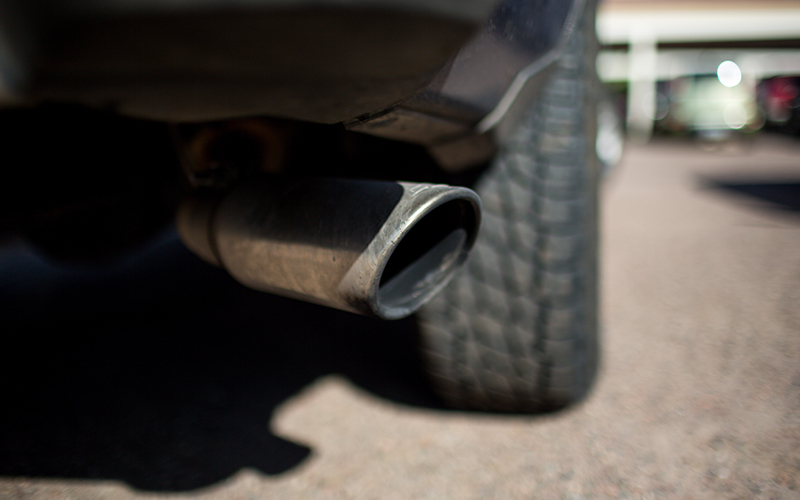
About a third of Americans are susceptible to ozone-related health problems, and ozone is the Valley’s most difficult particulate matter to battle, according to Maricopa County’s Department of Air Quality. (Photo by Nicole Neri/Cronkite News)
PHOENIX – A cold front sent wind gusts up to 50 mph through metro Phoenix last week, prompting the National Weather Service to issue an air quality alert for people to limit their time outside because of increased dust and other pollutants.
For those with respiratory issues, windy days can trigger coughing, sneezing, shortness of breath and other symptoms.
Hannah Romero-Reyes, 20, and her father, Carlos Reyes, have struggled with asthma their whole lives.
“A windy day really affects me,” said Romero-Reyes, who’s a Grand Canyon University sophomore. “I start coughing a lot.”
On days when there is an air quality alert, Romero-Reyes said she still goes about her normal day but carries an emergency inhaler.
“There’s always issues for people with heart or lung diseases, especially children because their lungs are still developing,” said Bob Huhn, spokesman for the Maricopa County Department of Air Quality.
Although strong winds and other weather conditions can decrease air quality, Maricopa County is on track to have better air quality overall this year compared with last year. But the rapidly growing county, which is home to more than 4 million people, still struggles to keep ozone levels below federal standards.
“The numbers for the particulates that we monitor for dust, smoke and ozone are all down from the previous year,” Huhn said.
One reason Maricopa County has remained below federal health standards this year is the above average rain Arizona has received since late summer, he said.
“The overall trend for the last 25 years is that the air quality is improving,” Huhn said. “For example, carbon monoxide was an issue several years ago, now it’s on the radar.”
Even so, the county still faces challenges with air quality and has struggled to comply with federal ozone regulations.
Ground-level ozone forms when pollutants from cars, power plants and other sources (known as volatile organic compounds, or VOCs) chemically react with sunlight, according to the Environmental Protection Agency, creating unhealthy air.
Maricopa, Pinal and Gila counties failed to meet EPA standards starting in 2008 and have had to come up with plans over the years to address this.
According to the Arizona Department of Environmental Quality, the EPA classifies non-attainment areas as those with air quality monitoring data for criteria pollutants above the National Ambient Air Quality Standards, which are outlined in the Clean Air Act, which Congress passed in 1970 and has since amended.
Peak ozone season is underway and will last through the end of September. Already this year, Huhn said, there have been four ozone health watches.
“For ozone right now, we have not been able to meet the federal health standards,” Huhn said.
In October 2015, the EPA lowered the standards for ozone from 75 parts per billion to 70 parts per billion, but the change did not bring Maricopa County back into compliance.
“It’s been a challenge for not only us, but counties across the country to meet that,” Huhn said.
About a third of Americans are susceptible to ozone-related health problems, and ozone is the Valley’s most difficult particulate matter to battle, according to Maricopa County’s Department of Air Quality.
Ozone is such a problem because it’s colorless, making it hard to monitor, and the Valley receives a lot of direct sunlight, which creates ozone.
The county Department of Air Quality launched a Commit to One Day, Keep Ozone Away campaign, which is aimed at single occupancy drivers to encourage people to commit to one day a week to ride their bike, walk, carpool or take public transportation to their destination.
Huhn said people can also refuel their vehicles after sunset, and rather than idling in a drive-through food line, park their car and order inside.
As temperatures creep into the triple digits this summer, Huhn said there are also ways people can help improve air quality during the dry heat.
“On no burn days when the concentration levels for smoke are expected to be higher than what’s healthiest, please abide by the rules and regulations,” Huhn said.
When the dust levels are high, the public should also avoid using leaf blowers or off highway vehicles that may kick up dust.
The EPA grants Maricopa County exceptions to air quality during extreme weather, Huhn said, but it is the responsibility of local and state agencies to create rules and regulations that residents and businesses have to abide by to maintain healthy air.
“If the year continues to worsen, it’d be tougher regulations, tougher rules and could be higher fine for residents,” Huhn said. “Eventually, we could lose federal funding, and that could mean jobs on the line.”
AlertMe